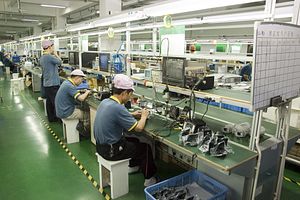China’s Thirteenth Five-Year Plan has now been approved by the Central Committee of the Chinese Communist Party and will be finalized and fully released in March 2016. A communiqué issued after the Fifth Plenum last week states that the plan seeks to promote innovation, green development, online economic activity, social insurance, and the further opening up and reform of financial markets, among other goals. These targets build on previous policies, in some cases reinforcing them, in others extending them, and are therefore quite realistic.
First, China’s leadership has already stated that it would promote innovation, in particular through its “Made in China 2025” program, which seeks to expand the integration of innovation into industrial and services industries. The Thirteenth Five-Year Plan references this program. The impact of technology upgrading within production processes will increase both productivity and profitability of goods and services. This process is essential in catering to a more highly-skilled workforce that now largely balks at taking jobs in the low-skilled manufacturing sector. Higher wages earned by skill-intensive jobs can be used to increase consumption, a major focus of the current administration.
Second, green development has been a general target for some time, although somewhat new objectives within the upcoming Five-Year Plan may enable better success. The proposed real-time online environmental monitoring system can help enforce pollution laws currently on the books. This was introduced in a trial phase at the beginning of 2014, requiring factories to report air emissions every hour and wastewater discharges every two hours, posting the results to the Internet. Also, a strict water management system will place reasonable prices on water and better regulate this increasingly scarce resource. This will enhance a green development program that has thus far focused mainly on developing renewable energy sources and moderately increasing enforcement of pollution laws.
Third, expanding economic activity on the Internet has been a focus within the “Internet Plus,” program introduced by Premier Li Keqiang in March of this year. Internet Plus seeks to integrate big data, the Internet of Things, and mobile internet with manufacturing, and to promote e-commerce. Under this plan, the Internet is to be used to promote innovation and boost the primary, secondary, and tertiary sectors. Much of the growth in China’s Internet industry has been organic, coming from the private sector. Integrating the Internet into regular business processes requires somewhat better coordination, which is what this policy seeks to accomplish.
Fourth, social insurance will be increased. While Chinese citizens more or less have universal health coverage, coverage often falls woefully short of paying for major medical expenses. To address this issue, medical insurance coverage for serious illness will be rolled out; this was announced in August and is also part of the latest Five-Year Plan. Fifty percent of the costs for critical illnesses will be covered. In addition, the pension system is to be improved. Reforms to the pension system were made in January of this year, requiring workers in government agencies and public institutions to pay 8 percent of their salaries into the old-age insurance fund.
Fifth, further opening up and reform of financial markets are to occur, to improve capital markets, usher in RMB capital account convertibility, and join the IMF basket of reserve currencies. This is already underway, as similar financial reforms have been on the agenda since the Third Plenary Meeting of the 18th CPC Central Committee. Of all of the different kinds of reforms, financial reforms have occupied much of the leadership’s focus. China has just this year removed the deposit interest rate ceiling, introduced deposit insurance, and opened up the capital account for companies and banks in the Shanghai Free Trade Zone to raise funds. The transformation of China’s financial economy to a more liberalized market requires many reforms, but these are occurring at a steady pace.
In sum, the fact that most of the reforms proposed for the Thirteenth Five-Year Plan are already underway in some form renders them realistic and achievable. Plans have already been made within the complex government bureaucracy to achieve these targets, with funds allocated and expectations set. Although Five-Year Plans are now viewed as goals rather than hard targets, it seems a safe bet that China will accomplish many of these objectives. Moreover, the goals are in line with China’s overall restructuring aim of shifting from a low-skilled manufacturing economy to a high-skilled manufacturing and services, consumption-based economy. Despite the strong currents slowing the economy at present, China continues to travel down a sensible path.

































